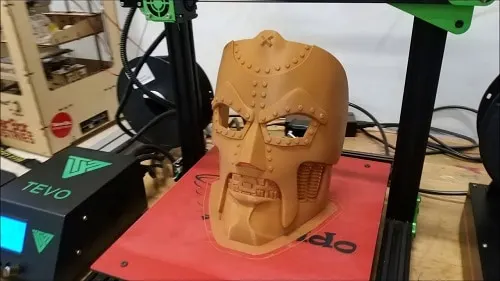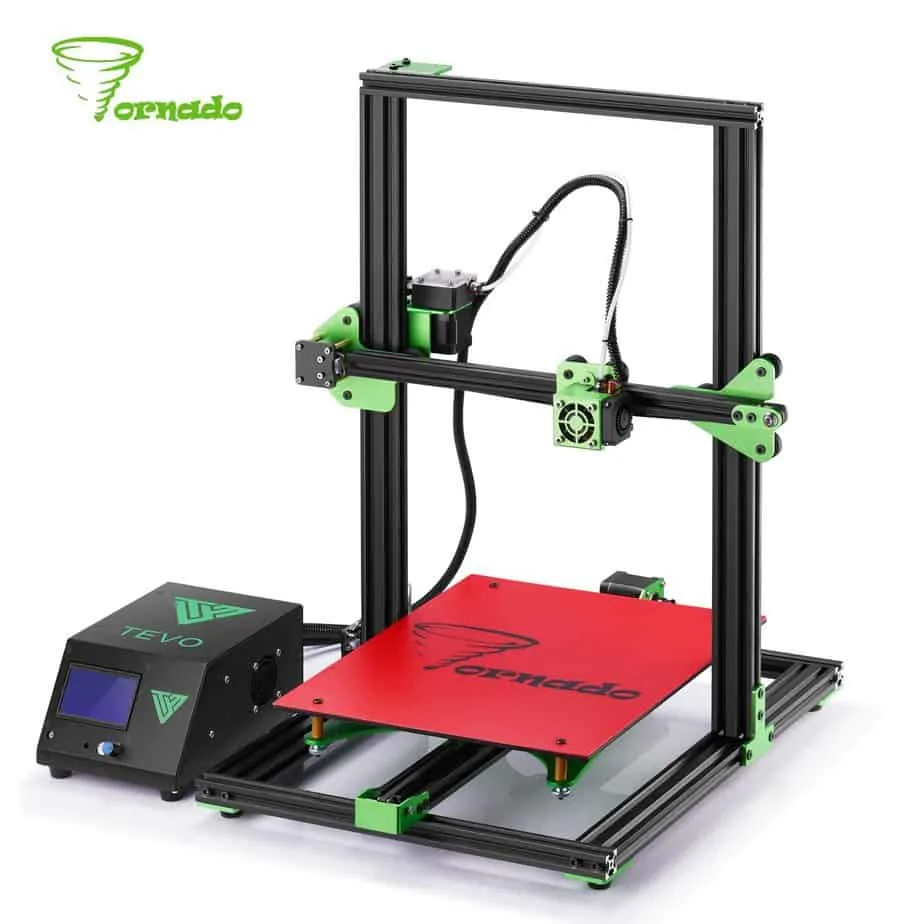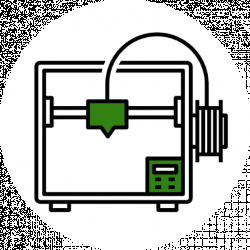- Creality Ender vs Anet A8 [2022]: Which is Better? - April 14, 2022
- TEVO Tornado Review [2022] All You Need To Know - April 6, 2022
- Anet A6 Review [2022 UPDATED Version] - April 5, 2022
Personal 3D printing is getting big in more than one way. The evolution of hardware is catching up to the needs of large build volume printing, starting with the physical size of the printing area and progressing to lower price range per square inch so that more enthusiasts can experiment with designs they would otherwise either have to pass up or print in separate pieces.
TEVO, a 3D printer company from China that gave us a lackluster printer build kit with its Tevo Tarantula model, enters this ring with its new Tornado, a large-scale printer that comes almost entirely assembled and still fits on a user’s home desk.
Its bed heated through AC and its Titan extruder (also made by TEVO), makes it stand out in the affordable 3D printing pack; and TEVO improves on its build it yourself origins by shipping this one out 95% assembled, bypassing a lot of the complaints about confusing instructions and thus improving on itself already. But is it worth it as part of the general 3D printing market? Let’s find out!
Table of Contents
TEVO Tornado Printer Kit Overview
The Tornado Printer Kit was introduced in 201f7 and is still technically sold as a kit, as are all of TEVO’s printers. TEVO itself was established in 2015 and has earned three international certifications: CE, which certifies it’s up to safety standards in the single market in the European Economic Area; FCC, which means it means safety standards in the United States; and ROHS.
This also means that the 3D printed parts are calibrated to hold up to but not beyond the specified maximum levels at which it’s safe to use them. This results in TEVO being able to ship to multiple areas in Europe and the United States, as well as elsewhere around the world, so wherever you happen to live, chances are you’ll have the chance to try this company if you want.
Their other products include printer kits for half a dozen models, spare parts, and a variety of filaments, so they’re striving to become your one spot for all your budget 3D printing needs. But you can also purchase a Tornado on Amazon, Banggood, or GearBeast. Check out the latest prices on Amazon.
Features
The Tevo Tornado 3D Printer has striking coloring, bright green frame elements, and red printer bed stickers combining for a Christmasy look. (Plan on replacing these stickers after a few paintings; they tended to bubble up on previous models so it’s a good plan to keep a stash of your own just in case).
It’s also got aluminum extrusions. Its frame style takes its inspiration from Creality CR 10, but the Titan extruder is all TEVO’s own design. The Tevo Titan extruder is mounted to the left of the X-axis rail when you look at it straight on, and it pushes filament through a PTFE (Polytetrafluoroethylene) tube into the hot end.
One excellent design point is the lead screw, which is fixed at both ends and is great for stability. This is especially useful for prints that take up the whole 400 mm height of the printing area. The X and Y axes could benefit from fixed adjustment knobs, but it’s easy enough to adjust both of them by loosening nuts and pulling them taut before tightening again.
There are two major areas that need improvement. First, the control box is not part of the printer frame itself but is its own separate box attached to the frame with a cord.
The cord is short enough that the control box has to stay close enough to potentially get knocked over or interfere with the extruder during a print that takes the nozzle outside of the printer bed.
This poses a threat from cables potentially getting caught on the edge of the printer bed frame, and it can also limit the number of extras you would be able to confidentially fit onto the Tornado 3D Printer, which limits its potential to grow with your 3D printing skills.
The not so good
Another issue is a major potential safety hazard. The AC powered heating bed is great for getting the printing bed to its optimal heating temperature fast. But, this also means that you’re going to essentially have an open hot plate that you will have to be extremely careful about while using the other parts of the printer.
The wiring for the Tevo Tornado 3D Printer’s power supply is attached directly to the bed via soldering, which means there’s a chance that the live cables could work free from agitation from some part of the printer’s work and shock you through the frame because there’s no apparent grounding of these cables.
Also, the insulation on these cables is a thin single layer that can be easily slit from, for example, an attempt to scrape a print off the bed. There’s not any stress relief for the unsupported mains-carrying cables into the bed.
They are soldered into place, but the hours of continuous zagging motions that are the hallmark of 3D printing could easily knock them askew into hazardous positions. There aren’t any given strain reliefs for the cables in the original kit, either, so it’s a good idea to get paranoid and make some for yourself before you start any serious printing projects.
Specifications
| Company | TEVO |
| Price | $358 |
| Type | 95% assembled kit |
| Weight | 14 kg |
| Overall printer dimensions | 560 mm x 600 mm x 620 mm |
| Print bed size | 300 mm x 300 mm x 400 mm |
| Maximum print area | 300 mm x 300 mm x 400 mm |
| Maximum print speed | 150 mm/sec |
| Layer resolution | 50 microns (0.05 mm) |
| Filament diameter | 1.75 mm |
| Filament types | PLA, ABS, PETG, wood, PVA, flexible filament |
| Positioning accuracy | 0.004mm Z-axis, 0.012 X/Y axes |
| Nozzle diameter | 0.4 mm |
| Maximum extruder temperature | 260 degrees Celsius |
| Heating plate temperature | 60 – 110 degrees Celsius |
| Power requirements | 220V, 250W, 50Hz, 0.89A |
| Connection | TF card or USB |
| File formats | STL file, G-code |
| Compatibility | Windows, Linux, Mac |
The Kit
Once you decide where to order your printer from, it comes in a box thoroughly padded with foam and filled with bags of labeled screws, including extras, which comes in handy to keep around in case anything comes loose or out of true later on in your usage.
As mentioned, it’s not in nearly as many pieces as your usual 3D printing kit. But it’s not all the way constructed; you do have to put together the combined Z and X axes, the printer bed, and the control box.
You’ll also get a scraper to help you take the prints off the bed, which is a basic flat spatula-like blade with a wooden handle, an SD card with test designs, and all the necessary power cords.
It’s got the TEVO logo printed all over the pieces; make sure those are in good condition, which is how you’ll know you’ve gotten a new kit and not one that may have been refurbished and sold to you without your prior knowledge. Refurbished hardware is a great money saver if you know that’s what you’re buying, but look out for companies trying to pass off those as new.
One important area where TEVO has majorly stepped up its game is the assembly instructions. As mentioned in our Tevo Tarantula review, the kit that required more assembly had instructions that could frustrate even the most seasoned engineer, much less the hobbyists TEVO’s printers are aimed at.

But, the Tornado’s booklet has clearly printed and labeled photos as well as a logical flow to its directions. However, two things came to mind while using these: first, there isn’t a step that explicitly tells you how to attach the heated bed to the Y-axis carriage.
This will be fairly obvious for those who have worked with 3D printers before and are familiar with their general construct, but if this is your first kit, make sure you find out how to make that last attachment correctly before you proceed. Unfortunately, the Tornado 3D Printer instructions won’t be much help for that.
Secondly, you do have to remember that this kit has a lot fewer parts to deal with than the full build kit of the Tarantula, so the instructions may not actually be improved but just simpler.
No specific software comes bundled with the printer, which means you can take your pick on what you use, but it also means you’ll have to either already have a drafting program or get one separately before you use the Tornado.
But if this is your first 3D printer, there are a lot of free software options online, all of which the Tornado instructions packet tells you about. If this is another step further into your 3D printing journey, you’ll more than likely already have a preferred program that will gel with the Tornado’s system.
If you’re looking for an idea, Simplify3D has a settings profile set up for the Tornado, as does Cura. Both of these can be found with some easy Googling.
The Assembly
You won’t get a feel of how 3D printers are assembled if you buy the Tornado, but you do get an easy assembly. The tall standing part of the frame that also contains the X-axis rail, carriage, hot end, and belt and the Tevo Titan extruder goes together with the AC heating bed with its cabling.
Then you put together the base unit with its Y-axis and carriage, stepper motor, and belt with its control and power unit. It only sounds complicated because there are a lot of parts, but for the most part, they are already attached where they need to be and you’re just putting the large chunks together.
However, the process will not be completely painless. One thing that seems like it would be useful is the labeled packages of screws and attachment paraphernalia. But that gets frustrating when you realize that nothing corresponds to these labels, either on the printer itself or in the instructions, so it will take you extra time and frustration to figure out what is supposed to be used where.
Also, several of the cables are too short to comfortably reach their plugs, which while technically letting you get everything together have the real potential to become a problem sooner rather than later when you start printing in earnest.
There’s a simple solution to this, however – cut the spiral coverings of the cables, and they can reach what they need to with some safe give. The coverings, which look like landline phone cords, don’t seem to serve the purpose they’re meant to, so don’t worry about pulling them apart for a better build.
The Printing Process
The Tornado boots up well with a manual bed level, although if you power it down between leveling and printing you may come across a bug that wipes out your control box settings. That’s something TEVO has an address with a workaround that lets you connect your printer to your computer to wake it back up. This is a known firmware issue, so hopefully, there will be future updates that eliminate it.
Another issue that comes up in the middle of printing is not so easily fixed, mainly because the print itself does not give any indication of what’s actually wrong and merely stops printing in the middle of the design.
By methodically examining mechanical parts for connections that may have gotten loose and software error messages, we found an issue with the SD card that came with the printer kit.
Once we transferred the design to a USB drive and used that to feed the design to the Tornado, it printed the whole thing without a hitch, and with future projects that used a personal favorite brand of SD card instead of the provided one worked fine too.
And it came out fairly nicely, especially for a first print. There were a few strands across the bridgings, but they were small and insignificant enough to trim away without leaving any lasting impression on the final product.
But several oddly bulging areas warrant a closer inspection of the printer’s calibration methods, and the object showcases TEVO’s ongoing problem of “salmon skin” finish, which is a hallmark of a jerky printer head caused by the stepper motors that handle how that head moves.
You can fix that by purchasing new drivers or add smoothers between the board and steppers, but that may not be something you want to deal with.
Other designs that take advantage of the printer’s bigger size show the same tendencies, enough to warrant the fixes mentioned above or a separate finishing process that gets you the surface you want.
If you’re planning on mixing materials, printing something with a lot of sharp turns in the design, or needing to load more than one filament to finish it, the Tornado printer isn’t the best print quality you can get. However, if your designs are mostly smooth, one-filament wonders, you’ll get a good quality finished product.
FAQs About TEVO Tornado
If you have bought the TEVO Tornado, good news for you, you can use plenty of different materials like PLA, wood, PVA, ABS, PETG and lots of different flexible filaments to create your desired object.
Unlike some other 3D Printers that only work with one system, the TEVO Tornado operates with Windows, Linux, and Mac.
No. Unfortunately, besides selling extra parts for the printer that make it faster at printing, the company does not sell filaments, but you can find compatible ones easily online.
Final Verdict
The Tornado is a definite improvement over previous TEVO kits in both assembly ease and final product quality. It is priced at about the point of a low-end fully-assembled machine and does have some print quality issues to overcome, but it may be worth it for you for the enlarged printing area alone. But if you’re not specifically looking for a bigger printer that is still affordable, you may want to look elsewhere.

![TEVO Tornado Review [2022] All You Need To Know](https://total3dprinting.org/wp-content/uploads/2019/01/The-TEVO-Tornado-Printer-Kit-Review.png.webp)

